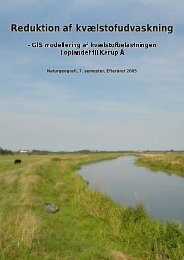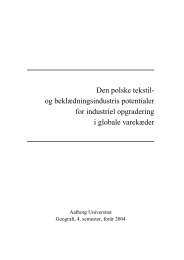Deglaciation dynamics following the Little Ice Age on Svalbard:
Deglaciation dynamics following the Little Ice Age on Svalbard:
Deglaciation dynamics following the Little Ice Age on Svalbard:
Create successful ePaper yourself
Turn your PDF publications into a flip-book with our unique Google optimized e-Paper software.
Søren H. Rasmussen<br />
Previous work<br />
Lønne and Lyså (2005) have made a<br />
detailed geomorphologic map of Platåbreen.<br />
They divide <str<strong>on</strong>g>the</str<strong>on</strong>g> ice-marginal landscape<br />
into five different z<strong>on</strong>es: 1) glacier<br />
ice, with a thin debris mantle locally,<br />
including medial moraines; 2) proglacial<br />
areas influenced by glacial meltwater; 3)<br />
ice-cored termino-lateral moraines; 4)<br />
areas deglaciated after <str<strong>on</strong>g>the</str<strong>on</strong>g> LIA maximum,<br />
and 5) areas not directly affected by this<br />
glacial event.<br />
They describe <str<strong>on</strong>g>the</str<strong>on</strong>g> five z<strong>on</strong>es and<br />
document with pictures. From historical<br />
aerial photos <str<strong>on</strong>g>the</str<strong>on</strong>g>y find <str<strong>on</strong>g>the</str<strong>on</strong>g> terminus at<br />
different years. They end up with a four<br />
stage model of <str<strong>on</strong>g>the</str<strong>on</strong>g> evoluti<strong>on</strong> of Platåbreen,<br />
from early LIA to fully deglaciated basin.<br />
Every stage show shifting in geomorphologic<br />
z<strong>on</strong>es in different areas.<br />
They c<strong>on</strong>clude that <str<strong>on</strong>g>the</str<strong>on</strong>g> evoluti<strong>on</strong> of <str<strong>on</strong>g>the</str<strong>on</strong>g><br />
landscape can be divided into tree phases:<br />
Temperate glacier, cold-based ice and n<strong>on</strong>glacial<br />
c<strong>on</strong>diti<strong>on</strong>s. Erosi<strong>on</strong> by glacial meltwater<br />
is <str<strong>on</strong>g>the</str<strong>on</strong>g> most notable landscape process,<br />
and study of modern analogical glacial<br />
meltwater processes can improve rec<strong>on</strong>structi<strong>on</strong><br />
of glacier.<br />
Lukas et al. (2005) has made a detailed<br />
study of <str<strong>on</strong>g>the</str<strong>on</strong>g> debris-covered fr<strong>on</strong>tal icemargins<br />
of L<strong>on</strong>gyear-, Lars- and Platåbreen.<br />
They have mapped <str<strong>on</strong>g>the</str<strong>on</strong>g> geomorphology<br />
of <str<strong>on</strong>g>the</str<strong>on</strong>g> glaciers and measured clast<br />
shape and roundness. They c<strong>on</strong>clude that<br />
cold-based to poly<str<strong>on</strong>g>the</str<strong>on</strong>g>rmal, high-arctic glaciers<br />
can not be used as modern analogues<br />
for well-preserved Quaternary glacial landforms<br />
such as those in <str<strong>on</strong>g>the</str<strong>on</strong>g> Scottish Highland.<br />
This building <strong>on</strong> <str<strong>on</strong>g>the</str<strong>on</strong>g> remains of deglaciating<br />
of <str<strong>on</strong>g>the</str<strong>on</strong>g> three present glaciers is<br />
dump moraine due to glaciofluvial rework<br />
and removal.<br />
Lønne and Lyså (2005) and Lukas et al.<br />
(2005) agree in <str<strong>on</strong>g>the</str<strong>on</strong>g> importance of glaciofluvial<br />
processes for preservati<strong>on</strong> of modern<br />
<strong>Svalbard</strong> glacier’s moraines.<br />
<str<strong>on</strong>g>Deglaciati<strong>on</strong></str<strong>on</strong>g> <str<strong>on</strong>g>dynamics</str<strong>on</strong>g> <str<strong>on</strong>g>following</str<strong>on</strong>g> <str<strong>on</strong>g>the</str<strong>on</strong>g> <str<strong>on</strong>g>Little</str<strong>on</strong>g> <str<strong>on</strong>g>Ice</str<strong>on</strong>g> <str<strong>on</strong>g>Age</str<strong>on</strong>g> <strong>on</strong> <strong>Svalbard</strong>:<br />
Implicati<strong>on</strong> of debris-covered glaciers dynamic and morphological setting<br />
Page 3 of 15<br />
Lukas et al. (2006) comment <strong>on</strong> <str<strong>on</strong>g>the</str<strong>on</strong>g><br />
work of Lønne and Lyså (2005). Here is a<br />
review of some of <str<strong>on</strong>g>the</str<strong>on</strong>g> points. Use of <str<strong>on</strong>g>the</str<strong>on</strong>g><br />
term “ice-cored moraine”: Lukas et al.<br />
(2006) claim that with using <str<strong>on</strong>g>the</str<strong>on</strong>g> term “icecored<br />
moraine” it implicit say that <str<strong>on</strong>g>the</str<strong>on</strong>g> ice<br />
in <str<strong>on</strong>g>the</str<strong>on</strong>g> moraine is dead-ice that is detached<br />
from <str<strong>on</strong>g>the</str<strong>on</strong>g> glacier. Lukas et al. (2006) has<br />
made a cross profile of <str<strong>on</strong>g>the</str<strong>on</strong>g> debris-cover of<br />
Platåbreen, with show supraglacial debris<br />
<strong>on</strong> clean glacier ice. This means <str<strong>on</strong>g>the</str<strong>on</strong>g> fr<strong>on</strong>t<br />
of <str<strong>on</strong>g>the</str<strong>on</strong>g> glacier is a debris-cover glacier and<br />
not a dead-ice “ice-cored moraine”. Lønne<br />
and Lyså (2005) have identified former<br />
ice-fr<strong>on</strong>t positi<strong>on</strong>s through aerial photos,<br />
but Lukas et al. (2006) observati<strong>on</strong>s<br />
claimed <str<strong>on</strong>g>the</str<strong>on</strong>g> active glacier c<strong>on</strong>tinued under<br />
<str<strong>on</strong>g>the</str<strong>on</strong>g> debris and <str<strong>on</strong>g>the</str<strong>on</strong>g>refore <str<strong>on</strong>g>the</str<strong>on</strong>g> real ice-fr<strong>on</strong>t is<br />
still at LIA positi<strong>on</strong>.<br />
Lukas et al. (2006) have not found any<br />
thrusting <strong>on</strong> Platåbreen and <str<strong>on</strong>g>the</str<strong>on</strong>g>refore <str<strong>on</strong>g>the</str<strong>on</strong>g>y<br />
say it is unlikely that a subglacial transport<br />
is a source for some of <str<strong>on</strong>g>the</str<strong>on</strong>g> debris at <str<strong>on</strong>g>the</str<strong>on</strong>g><br />
surface. Far<str<strong>on</strong>g>the</str<strong>on</strong>g>r more <str<strong>on</strong>g>the</str<strong>on</strong>g> shale would have<br />
been crushed under <str<strong>on</strong>g>the</str<strong>on</strong>g> subglacial transport.<br />
Lønne (2006) is a reply <strong>on</strong> Lukas et al.<br />
(2006) comment. One of <str<strong>on</strong>g>the</str<strong>on</strong>g> points is that<br />
moraines can be ice-core with out <str<strong>on</strong>g>the</str<strong>on</strong>g> ice<br />
being dead-ice.<br />
In <str<strong>on</strong>g>the</str<strong>on</strong>g> forefield of Larsbreen are rockglaciers.<br />
These and <str<strong>on</strong>g>the</str<strong>on</strong>g> additi<strong>on</strong>al talus<br />
c<strong>on</strong>es has been m<strong>on</strong>itored and studied by<br />
Humlum (2005), since 1999.<br />
Glasser and Hambery (2006) presented<br />
a landsystem model for a typical terrestrial<br />
<strong>Svalbard</strong> poly<str<strong>on</strong>g>the</str<strong>on</strong>g>rmal glacier. The model is<br />
based <strong>on</strong> observati<strong>on</strong> of modern <strong>Svalbard</strong><br />
glacier and <str<strong>on</strong>g>the</str<strong>on</strong>g> published literature. This<br />
model will be used for comparis<strong>on</strong> with<br />
Larsbreen and Platåbreen, as a reference<br />
model for <strong>Svalbard</strong> glacier. The model<br />
divides <str<strong>on</strong>g>the</str<strong>on</strong>g> glacier forefield in tree, see<br />
figure 2:<br />
Outer moraine ridges: steep ridges up to<br />
15-20 m height, with usually are ice<br />
cored.







